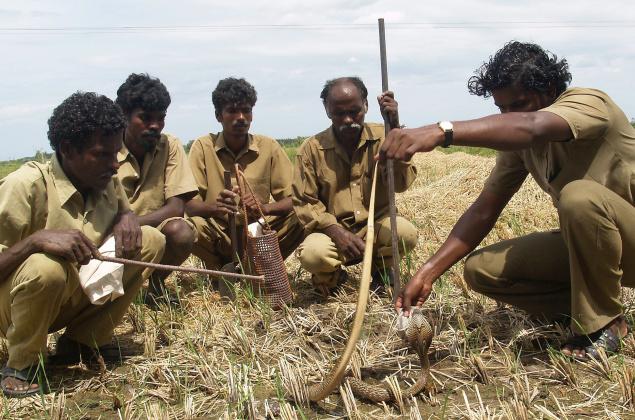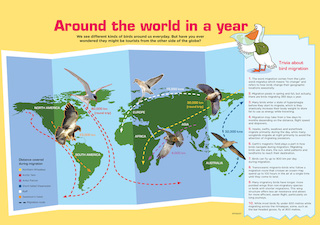
Photo credit: M. Karunakaran © The Hindu >>
Learn more about the Irula community & Snake >>
The term Irula means being capable of finding one’s path in dark forests, according to an Irula myth | Read the full report in the Times of India here >>
Born in nature’s lap, Irulas share a symbiotic relationship with Mother Earth. They reside in the hills of northern Tamil Nadu and are one among the six oldest Adivasi tribes.
Irulas are specialists in traditional herbal medicine and healing practices. Irula vaidyars, mostly women, practice traditional healing systems, which use over 320 medicinal herbs.
They treat several new-age diseases with a high success rate. People around the world realize that traditional healing practices must have a place in modern medicine.
The Irula Tribal Women’s Welfare Society (ITWWS), established in 1986, focuses on this traditional science. […]
Source: “Irula’s tribal secrets unraveled”, Times of India, 29 March 2005
Address: https://timesofindia.indiatimes.com/business/india-business/Irulas-tribal-secrets-unraveled/articleshow/1064853.cms
Date Visited: 15 June 2022
K.S. Nikhil Kumar, The Hindu, April 19, 2008 | Read the full report here >>
CHENNAI: The Irula Tribal Women’s Welfare Society has tied up with the Tamil Nadu Tourism Development Corporation (TTDC) and is attempting to enter the tourism sector through rural tourism and eco-tourism. Being very close to Mahabalipuram (20 km away) and only about 90 minutes drive from Chennai, Thandarai is an ideal place for tourists to experience a slice of rural life in Tamil Nadu.
The Irulas are very fond of music and dance, and will therefore ensure that their guests are entertained, according to ITWWS chief executive officer Reuben Solomon.
The ITWWS is a pioneering set-up, in that it includes a sustainable and economically viable means of providing a very backward community of women a source of livelihood. It also simultaneously educates their children, sensitises everyone who comes there about the surrounding ecology and documents the knowledge of the Irulas about the techniques of herbal medicine and the species of medicinal plants.
Koveri Devi, the environmental co-ordinator and in-house botanist, says: “This is a great model for people from tribal backgrounds to be integrated with modern society. It not only secures their economic needs, but it also ensures that they do not lose touch with their roots. It is environmentally sustainable and is very progressive in its structure because everyone has an equal share in the set-up. We have so far had many foreigners visiting us to experience the real India — rural India.” […]
They are primarily hunter-gatherers and until 50 years ago, got all their day-to-day food and medicine from the forest. They are famous for their snake-hunting skills, but were rendered homeless and jobless in the 1970s after the areas where they lived were declared reserved forests and the sale of snake products was prohibited. However, since then the Irulas have found employment in various areas due to their immense knowledge of the flora and fauna of the region.
The women are very knowledgeable with regard to the plant species, particularly the medicinal varieties. This knowledge has been passed on from many generations and some of the women are ’Vaidyas’ (traditional doctors).
Source: Irula women’s society plans foray into eco-tourism – TAMIL NADU – The Hindu
Address: https://www.thehindu.com/todays-paper/tp-national/tp-tamilnadu/Irula-womenrsquos-society-plans-foray-into-eco-tourism/article15206240.ece
Date Visited: 5 November 2021
“The tribal households traditionally had a backyard garden that had multiple, multilayered and multipurpose indigenous trees, plants, herbs, and shrubs. […] The produce from this small garden was sufficient to meet the dietary and nutrition needs of a family for an entire year.” – Learn more about food crops that are resistant to pests, grow on poor soils, flourish under changed climatic conditions and offer high nutritive value | Food distribution >>
Rajesh B Nair, The Hindu, December 25, 2016 | Read the full report here >>
The long-pending demand of Irular community here to have them included in the Scheduled Tribe category has been fulfilled, with the President giving assent to a recommendation made by the Union Cabinet in this regard.
The Presidential assent had paved the way for the Irular community, including its sub-castes Villi and Vettaikaran, to obtain reservation benefits for jobs in Central government offices and educational institutions. […]
The Irular community [i.e. settlements] numbering around 200 are spread across Puducherry and Karaikal regions. The community was traditionally hunter-gatherers. However, after the community was included in the Backward Tribe category, several of them obtained government jobs .
Source: Irular community granted Scheduled Tribe status – TAMIL NADU – The Hindu
Address: https://www.thehindu.com/todays-paper/tp-national/tp-tamilnadu/article16941486.ece
Date Visited: 5 November 2021
NAGAMMA, 55, is a vaidyar (traditional doctor), who is an expert in curing snakebites. She lives in Keerapakkam village, Chengalpet district, Tamil Nadu. One morning, Chinappa, a snake catcher, was bitten by a large cobra. He was taken to several doctors, but no one could cure him. He was gasping for breath and was about to die. In the evening he was taken to Nagamma. With some herbs, Nagamma prepared a medicine and gave it to him. By late evening he was ready to go home. | Read the full article >>
[…] Most of the Irula men and women are unaware of the wealth of their knowledge. Only a few organisations realise the importance of the knowledge of the Irulas and want to help them both socially and economically. The Irula Tribal Women’s Welfare Society (ITWWS) is one such organisation working for the welfare of the Irulas, particularly among the women. Its work for creating forest cover under the wasteland development programme has earned it a national award. The knowledge of herbal medicines has been documented by the ITWWS. Attempts have also been made to generate income for them through the preparation and sale of medicinal products. A centre with training facilities and a medicinal garden has been established.
EMPOWERING THE TRIBALS.
The ITWWS is a member of the Tamil Nadu Women’s Movement and the Joint Council of Tribals Association (ICTA). It has been working with them with the object of empowering tribal women, helping develop a common vision, identifying policy issues, and preventing violence against women. The ITWWS has been collaborating with other local NGOs to implement the latest Tribals Act and push for the inclusion of tribals in the Fifth Schedule. The ITWWS has also given training to some NGOs involved in tribal development. After the training programme at the ITWWS, several of the NGOs changed their approach. For example, some NGOs who earlier used to discourage traditional tribal activities and attitudes, are now trying to preserve the tribal culture and identity.
The ITWWS has initiated several income-generation programmes. A tree nursery project has seen 5,000 seedlings including medicinal species being planted. This project has also given employment for women. The herbal medicine programme uses the skills and knowledge of Irula vaidyars for preparing and marketing herbal medicines. It includes collection of plants and seeds,cultivation, exchanging information between vaidyars and researching market possibilities.
Source: “Losing jobs in the jungle” by Zai Whitaker, Down To Earth, 30 September 1998
URL: https://www.downtoearth.org.in/coverage/losing-jobs-in-the-jungle-22406
Date Visited: 5 November 2021
[Bold typeface added above for emphasis]
“The practice of religious rituals, ceremonies and sanctions by specific cultural groups allow such sacred landscapes to be maintained, emphasizing that humans are intrinsically part of the ecosystem. Taboos, codes and customs specific to activities and community members restrict access to most sacred groves. […] The inclusion of local people’s needs and interests in conservation planning is increasingly accepted as essential, both to promote the well-being of human populations, and to ensure that biodiversity and conservation needs are met in the long-term.” – Nazir A. Pala, Ajeet K. Neg and N.P. Todaria in “The Religious, Social and Cultural Significance of Forest Landscapes in Uttarakhand Himalaya, India” (International Journal of Conservation Science, Vol. 5, Issue 2, April-June 2014) | Sacred groves | Biodiversity and development – Himalaya >>
Up-to-date reports by Indian experts and journalists
Search tips
Combine the name of any particular state, language or region with that of any tribal (Adivasi) community.
Add keywords of special interest (health, nutrition endangered language, illegal mining, sacred grove); learn about the rights of Scheduled Tribes such as the “Forest Rights Act” (FRA); and the United Nations “Declaration on the Rights of Indigenous Peoples”, “Universal Declaration of Human Rights”, “women’s rights”, or “children’s right to education”.
Specify any other issue or news item you want to learn more about (biodiversity, bonded labour and human trafficking, climate change, ecology, economic development, ethnobotany, ethnomedicine, global warming, Himalayan tribe, hunter-gatherers in a particular region or state, prevention of rural poverty, water access).
For official figures include “scheduled tribe ST” along with a union state or region: e.g. “Chhattisgarh ST community”, “Scheduled tribe Tamil Nadu census”, “ST Kerala census”, “Particularly Vulnerable Tribal Group Jharkhand”, “PVTG Rajasthan”, “Adivasi ST Kerala”, “Adibasi ST West Bengal” etc.
In case the Google Custom Search window is not displayed here try the following: (1) toggle between “Reader” and regular viewing; (2) in your browser’s Security settings select “Enable JavaScript” | More tips >>
List of websites covered by this Google custom search engine
Academia.edu (platform for academics to share research papers) – www.academia.edu
Archive.org – https://archive.org
Centre for Science and Environment – https://www.cseindia.org
Current Conservation – https://www.currentconservation.org
Development and Cooperation (D+C) https://www.dandc.eu
Down To Earth (India) – www.downtoearth.org.in
India Environment Portal – www.indiaenvironmentportal.org.in
Harnessing Nature Magazine – https://harnessingnature.online
Mongabay-India – https://india.mongabay.com
M S Swaminathan Research Foundation – www.mssrf.org
Navdanya (protecting India’s biodiversity based food heritage) – https://navdanya.org
Third World Network (Penang, Malaysia) – https://twn.my
The Shola Trust (nature conservation in the Nilgiri region) – www.thesholatrust.org
Research the above issues with the help of Shodhganga: A reservoir of theses from universities all over India, made available under Open Access >>
Note: hyperlinks and quotes are meant for fact-checking and information purposes only | Disclaimer >>
For additional learning resources visit the website of the Centre for Science and Environment (CSE), “a public interest research and advocacy organisation based in New Delhi”:
Communication for Awareness
CSE’s publications and informational products have been its strength and they have always combined research and readability to get the message across.

CSE’s tools for awareness raising are periodicals, publications, films/short spots, briefing papers, exhibitions, posters and other products. CSE’s informational products reach people in more diverse ways such as features service, website and e-news bulletins. […]
Source: About CSE
URL: https://www.cseindia.org
Date Visited: 10 July 2022
- Health (Tamil Nadu) | State wise ST list (Scheduled Tribes)
- Indigenous healing practice
- Irula Tribal Women’s Welfare Society
- “Irulas are very knowledgeable about medicinal plants” : Interview with Zai Whitaker, Director of the Irula Tribal Women’s Welfare Society
- Sacred grove (Category)
Tips for using interactive maps
Toggle to normal view (from reader view) should the interactive map not be displayed by your tablet, smartphone or pc browser
For details and hyperlinks click on the rectangular button (left on the map’s header)
Scroll and click on one of the markers for information of special interest
Explore India’s tribal cultural heritage with the help of another interactive map >>
Explore India’s tribal cultural heritage with the help of several interactive maps, specially created for visitors to this website:
- An alphabetical journey across India: from Andaman to West Bengal
- Northeastern India: the “Seven Sister States” & Sikkim
- Visit a museum in India: Indigenous art, anthropological & ethnographical collections
- A virtual journey across time and space: from Gondi-Harappan to present & future
- Locations for video documentaries & external media contents
- Particularly Vulnerable Tribal Groups & Endangered languages
- Places associated with press reports and blogs about India’s tribal cultural heritage
- A virtual journey across India: from Ladakh to Gujarat